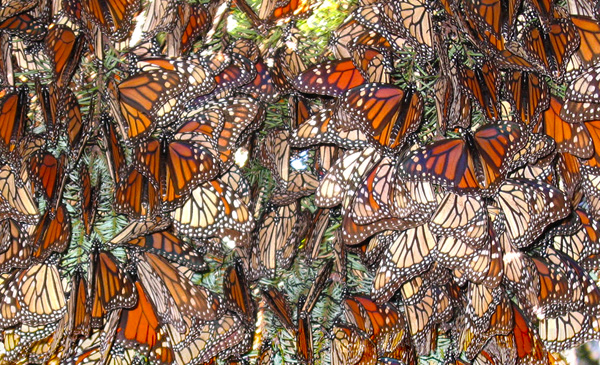Barbara Kingsolver’s insight into the complexities of human behaviour. [19 February 2013 | Peter Boyer]

Monarch butterflies rest in a mountain forest near near Angangueo, Mexico. [Photo www.nathab.com]
Our agency, along with the rest of the Australian public service, was asked to set up a performance appraisal system whereby managers and the people they managed would be assessed against “key performance indicators”.
I enjoy working with systems and threw myself into the exercise. Taking on board consultants’ advice about “quantifying everything”, I aimed for performance indicators that really worked.
But I failed. I couldn’t for the life of me nail a single useful indicator of the things that really matter in a workplace and everywhere else.
Those things that matter, the cogs that have to be oiled if an organisation is to succeed long-term, include quality of work, dedication and commitment, contribution to morale, support given to colleagues (regardless of status) and respect for everyone.
It’s easy to give the appearance of success with this kind of performance measurement, and senior bureaucrats and their political masters are all too happy to pick up on the results, the statistical “successes”, and run with them. But likely as not the statistics are hiding a dysfunctional workplace.
Numbers can show that something’s happening, but they can never nail the fundamental reasons for success or failure. Real performance success, where a person, workplace or community is really functioning as it should, can’t be quantified.
People’s interactions are as complex as they are unpredictable. How many times have we seen a picture-perfect workplace or community unravel without apparent cause, or an apparently ordinary, disorganised group achieve extraordinary success?
We’ve been wrestling with this complexity in our struggle for an appropriate response to climate change. Science has painstakingly built the case for a human cause and listed the steps needed to mitigate this, but lets face it, it’s clueless about how we make this happen.
Behind the public face we present to the world is an infinitely-complex internal realm that reveals much about human behaviour. Good fiction explores this hidden, tangled web of hopes and fears, memories and imaginings, in ways that can often reveal more than any factual account.
How people are motivated to change their ways would seem to be more in the realm of art than science. Perhaps that’s what attracted me to Flight Behaviour, the latest novel by prizewinning US author Barbara Kingsolver.
The contradictions of human behaviour, so frustrating to scientists and others seeking a unified, single-minded response to the climate crisis, is grist to the mill of a competent story-teller like Kingsolver.
Flight Behaviour begins with a sudden, dramatic change in animal behaviour. The monarch butterfly is famous for its migration between Canada and Mexico via the United States. During northern winters it is seen in spectacular abundance in the mountains around the city of Angangueo.
The story is about what happens to a young woman and her God-fearing community after she is literally awestruck by the seemingly divine sight of a million or so resting monarchs lit up by a setting sun in the hills behind her family’s southern Appalachian sheep farm.
The event is imagined, but it’s a reasonable fit with climatic and other changes already starting to occur in the butterfly’s Mexican habitat. But more to the point are the reactions of the woman, along with family, community and the wider world, to this apparent miracle.
Some locals see a dollar value in the monarchs as a tourist attraction, as they are in real-life Mexico. Others follow the lead from their pastor, seeing it as a troubling sign of God’s displeasure at human excess. But the young woman senses a more earthly explanation.
A science team takes up residence on the family farm, keen to work out the cause of the monarchs’ detour to this out-of-the-way place and whether they might survive an Appalachian winter, and the young woman is drawn to the science team.
Among the news reporters who descend on the farm is one who seeks to present the young woman as the instigator of the butterfly “miracle”. Her interview becomes an instant hit on the internet.
The ecologist leading the team does all he can to avoid reporters until trapped into an angry on-camera tirade about how the media misrepresents scientists and their method. He remarks bitterly that “as long as we won’t commit to knowing everything, the presumption is we know nothing”.
Refreshingly free of sermonising, the book highlights the folly of simple “solutions” in addressing shifts in the natural order. A city-based campaigner who tells the dirt-poor protagonist that we should all consume less is met with the obvious retort: how do you consume less than nothing?
In the continuing struggle to frame a response to the climate crisis, we would do well to ponder the varieties of human experiences described in Flight Behaviour, especially its message that different people can look at the same set of facts and come away with utterly different conclusions.
In a recent media interview Kingsolver told of her belief that while humans think they’re rational, the contrary is true. We take our truths from the people we trust in our families and communities. Having decided what’s true, we then look for facts to support that belief.
Which, as Kingsolver’s protagonist might have said, makes for one heck of a quandary.
